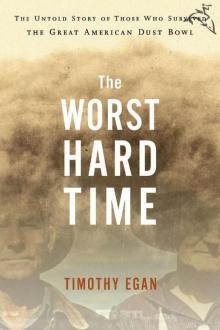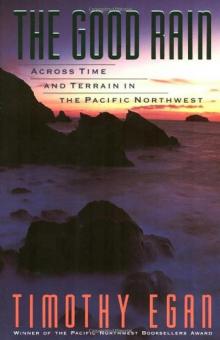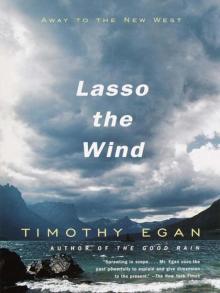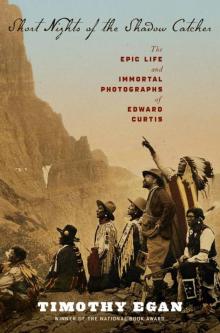- Home
- Timothy Egan
The Good Rain: Across Time & Terrain in the Pacific Northwest Page 16
The Good Rain: Across Time & Terrain in the Pacific Northwest Read online
Page 16
Plans were underway to unite all the Indians north of the Columbia in one big war when Leschi was captured in late 1856, after he was betrayed by his nephew. Stevens charged him with murder. Leschi’s white supporters argued that the Nisqually leader had done nothing more than engage in normal acts of war. The first all-white jury to hear his case was deadlocked, and a mistrial was declared. Leschi was tried again in the spring of 1857; this time he was found guilty and sentenced to death. After he was hanged from a tree not far from the land where he grew up, his executioner, Charles Grainger, said, “I felt I was hanging an innocent man.”
Leschi’s revolt, however minor in military terms, resulted in more land for the Puget Sound tribes. The Puyallups, including young Jimmy Cross, were given an expanded 23,000-acre reservation; most of them moved down from the bluff to their traditional land near the river and the bay, the very land that would be up for vote in the next century. Jimmy Cross learned to fish as his ancestors had, setting up weirs in the small streams which fed the Puyallup. In the spring, some early chinook would come home; later in the summer, they were followed by coho and fall chinook. Some years, the coho kept coming back right up until Christmas. When Jimmy Cross got older, he used to tell stories about why he was never hungry as a boy: all he had to do was reach down and pull up a salmon. For so many years, it was that simple.
Buoyed by his triumph in the initial round of treaty-making, Stevens sent a delegation east of the mountains to make pacts with the horse-riding, better-organized tribes of the upper Columbia River region. Five thousand Indians from the Nez Perce, Cayuse, Umatilla, Walla Walla and Yakima nations showed up for the Council of Walla Walla in 1855. Stevens wanted to clear the great river and its major tributaries of its traditional inhabitants to make way for miners, loggers and farmers. The Nez Perce, who had resisted the missionaries and were spared most of the recriminations that followed the Whitman massacre, held out for a large chunk of land, more than ten thousand square miles stretching from the salmon-rich desert streams that fed the Snake River to the elk country of the Wallowa Valley in northeast Oregon. Largely unsettled by whites, the Nez Perce land was conceded to the tribe. The other nations were to be sent to reservations on either side of the Columbia. Eventually, leaders representing the pro-treaty faction signed for all the tribes. In turn, each tribal leader was promised $500 a year over a twenty-year period. And that was it—in less than a year’s time, Stevens had convinced seventeen thousand Northwest Indians to give up 64 million acres. The treaties cost the federal treasury $1.2 million, or less than 2 cents an acre. But the ink was hardly dry when the tribes realized they’d been taken. Although Stevens had promised a two-year cushion before the Indian nations would be moved to the new reservations, he opened up their ancestral lands to settlers twelve days after the Treaty of Walla Walla was signed.
Kamiakin, chief of the Yakimas, forged a loose alliance of several inland tribes and declared war on the United States. But his grand plan to unite the coastal tribes and the inland tribes in one big campaign never bore fruit. The war was vicious on both sides: a sympathetic Indian agent was killed when he ventured into a Yakima tribal camp seeking justice for them; a chief of the Walla Wallas, Peo-peo-mox-mox, was captured at a peace parley and then murdered while in custody. The white troops paraded his scalp and ears before settlers. Small battles were fought throughout the year, but by winter the war had temporarily died down. During the hiatus, the government built two forts, one near the Yakima River, the other at Walla Walla near the Whitman mission.
In 1858, with the Coeur d’Alenes and Spokanes now aligned with Kamiakin, the fighting picked up again. In one battle, 1,000 natives routed 164 federal troops from Fort Walla Walla. Emboldened by the victory, the tribes took on a larger cavalry force near the Spokane River, but were badly beaten. They were pursued to their villages, their families killed, homes burned, leaders hanged.
Governor Stevens was called to the Civil War; on September 9, 1862, a Confederate bullet shattered his brain.
The Nez Perce, content with their ten-thousand-square-mile reservation on the Snake River and in the Wallowa Valley, had avoided the bloodshed of the Yakima Wars. As long as the whites left them with the land they had been formally awarded by treaty, they were fine; if they could live through the still-fatal vestiges of the smallpox epidemic, the Nez Perce expected to maintain themselves as one of the strongest Indian nations in the West. With the land they’d been allowed to keep, they might even prosper.
Soon, however, gold was discovered in the Wallowas, and precious-metal lust brought in a horde of well-armed trespassers. Pressured by miners, government officials called another treaty council and reduced the reservation by ninety percent, down to a thousand square miles, all of it in the high desert of western Idaho. One band of Nez Perce, led by Old Chief Joseph, refused to move, and returned across the Snake River to the longtime home in the green Wallowas. He lived there for ten years, until more trespassers claimed title to his land.
By the 1870s, there was a growing sympathy in the East for the remaining tribes of Indians in the West that had not been moved to the designated Indian Territory of Oklahoma. President Grant bent with the wind in 1873 and allowed the Joseph band of the Nez Perce to stay in their Wallowa Valley home. The tribe had received good press in Washington ever since they had fed the nearly starving Lewis and Clark expedition. But Grant’s order infuriated the white homesteaders, who placed him under great pressure; he promptly bent the other way and reversed his order. In May of 1877, General Oliver Howard ordered the Wallowa band, now led by young Chief Joseph, out of the fertile valley and across the Snake to the desert reservation. He gave them thirty days to close out their homes and leave. Enraged, a group of Nez Perce teenagers attacked several white settlers. More troops were called in for a big push against Joseph’s band, but the Nez Perce slipped away.
Leading 700 tribal members, 550 of whom were women, children and old men, Joseph crossed Hells Canyon and retreated up the eastern banks of the Snake, heading for high ground and reinforcements. Two battles were fought in Idaho, both stunning defeats for General Howard and his six hundred men, who were slow-moving—a big, blue-coated target—and unfamiliar with the territory. The Nez Perce, having sent their families farther east, broke up into small commando units and picked off Howard’s troops at random. They were first-rate marksmen, as are most hunters of today who chase the big game in the severe terrain above the Snake. While Howard’s bluecoats licked their wounds and called for help, the handful of Nez Perce warriors broke through the Bitterroot Range and headed toward Montana, hoping to gain an alliance with the powerful Crows. Traveling hundreds of miles on foot and horseback, they traversed harsh mountain country and entered Yellowstone, which had recently been set aside as the world’s first national park. Tourists camped at Old Faithful in the late summer of 1877 were stunned to see a fast-moving band of Indians pass through the park in the middle of a war. On the way to Yellowstone the Nez Perce had eluded one ambush but, after regrouping with their families, got trapped in another; eighty-nine people were killed, all but twelve of them women.
In Montana, the Crow refused to help them, so the Nez Perce headed for Canada, planning to hook up with Sitting Bull, the great chief of the Sioux who had been granted political asylum north of the border. A long wilderness trek through some of the meanest country in the Rocky Mountain West lay ahead. Many of the horses were lame, and the Nez Perce families began to starve. By late September, winter was closing in on the tribe just as hundreds of newly arrived troops were fast approaching them. Snow fell, hungry children woke up chilled by hypothermia, infected bullet wounds turned gangrenous. Joseph tried to keep hope alive, pressing toward Canada. Finally, on the bitterly cold morning of September 30, 1877, fresh infantry troops spotted the Nez Perce camp at Bear Paw, within a few days’ march of Canada. With howitzers and rapid-fire guns, the Americans pummeled the retreating refugees. On the second day of the siege, it rained; on the third day, it snowed. H
oward and his regiment caught up with the new troops and prepared to finish off Chief Joseph and his bedraggled band, who had eluded capture for 1,700 miles and gained the attention of the world. Reluctantly, Joseph surveyed his frostbitten, starving, dying people, the remnants of one of the strongest and most prosperous nations to live in the Americas, and gave up.
In his speech, recorded on the scene, Joseph said:
The little children are freezing to death. My people, some of them, have run away to the hills, and have no blankets, no food. No one knows where they are—perhaps freezing to death. I want to have time to look for my children and see how many I can find. Maybe I shall find them among the dead. Hear me, my chiefs, I am tired. My heart is sick and sad. From where the sun now stands, I will fight no more forever.
The last treaty ever made between the American government and an Indian nation was with the Nez Perce, in which their Wallowa land was given to the whites and they were scattered to the Indian Territory of Oklahoma and other places without salmon or elk. Years later, the federal government named a dam on the Columbia River after Chief Joseph; it was built without fish ladders, effectively killing off the last of the wild salmon runs that had been on the upper Columbia as long as the Nez Perce could remember.
With the Indian Wars over, government policy-makers tried to assimilate natives into the American melting pot by teaching them farming and property ownership. If the tribes had only been left with their reservations, they might have fared better as the twentieth century approached. Instead, things got even worse, especially for the Puyallups. President Lincoln had signed a bill in 1864 chartering the Northern Pacific Railroad for the purpose of laying track from Lake Superior to Puget Sound. Construction started in 1870, and approached the Cascades three years later. Every lumber town and three-shack burg around the Sound competed to be the railroad terminus. Tacoma, just beginning to take shape on the bluff near the Puyallup tribal village, got the railroad. But there was one big problem: the twenty-three-thousand-acre Puyallup reservation bordering Commencement Bay. This reservation had been granted to the Puyallups for eternity; by the terms of the treaty, it could never be sold. But that didn’t stop President Grant from signing an executive order, later judged to be illegal, which allowed the railroad to run right through the reservation. The Puyallups, of course, were never compensated for this passage. And as speculators caught the railroad fever, Puyallup land, once considered wetland trash, took on the gloss of a rough diamond. Joined by other real estate promoters in search of a loophole, the Tacoma speculators lobbied Congress for passage of the Allotment Act of 1887. Under this act, each male Indian head of household was given a chunk of reservation land, between 40 and 160 acres, which he could then sell as an individual.
This proved to be almost as devastating as smallpox or the wars. Impoverished, sometimes plied with liquor, most Indians quickly sold their allotments. In Oregon, the Siletz tribe went from owning 1.1 million acres in 1856 to less than three thousand in the mid-1890s. Nationwide, Indian landholdings shrank from 140 million acres to 48 million in less than fifty years. By selling their reservation lands piecemeal, the tribes lost their strongest hope for prosperity: a unified control of resources. Today, two-thirds of all Indian-reservation property is not owned by the tribes, a legacy of the Allotment Act.
Jimmy Cross took his allotment, a piece of valley land that flooded in the spring and brought salmon in the fall, and held on to it. He grew corn and carrots and berries, but mainly stayed alive with fish, which he caught and smoked and sold and ate year-round. By the time his grandson, Silas Cross, took over the family allotment in the mid-twentieth century, most of the fish had stopped coming back up the Puyallup. The tidelands at Commencement Bay, which were never sold in allotments, had been filled in; railroad and port facilities rose on the new ground. The river, also promised for eternity, was straightened, and the Puyallups were told they had no treaty rights to the new river or the old, dried-up bed. What siltation and industrial sludge didn’t do to the salmon run, the state did by allowing overfishing, all the while denying the Puyallups their seasonal access to fish, saying they would have to fish for salmon like everybody else. The Puyallups pointed to their treaty of 1854, approved by Congress and signed by the President, which guaranteed them the right “to taking fish at all usual and accustomed grounds.” The non-Indian fishermen were taking eighty-five percent of the catch. When a handful of Puyallups—Silas Cross, Bob Satiacum and Frank Wright, Sr., among them—tried to fish the new river outside the formal state fishing season, they were arrested, labeled poachers. Thus began the Fish War. The Puyallups would sneak out at night under cover of darkness and try to get a few salmon; the state game wardens were there waiting with manacles and TV cameras. Rocks were thrown, boats were sabotaged, occasional shots were fired. Marlon Brando came to the river in 1964, and was arrested with Satiacum.
After losing the Fish War in the river, the tribe took to the courts. And while Frank Wright, Sr., and Silas Cross continued the fight in the legal trenches, Bob Satiacum went another way, setting up a network of smoke shops that sold tax-free cigarettes, booze and the kind of fireworks a kid couldn’t get at the local Safeway booth. A convincing speaker, Satiacum soon became the most powerful Puyallup in modern times. Tracing his ancestry to a leader who signed the Medicine Creek Treaty with Governor Stevens, Satiacum declared himself chief, a title which was soon elevated, at a national Indian conference, to Chief of Chiefs. At his height, he owned four smoke shops, liquor stores, casinos, a pizza house, a wholesale tobacco company, a cabinet shop and a gift shop, and he sold his own Chief brand of liquor. In a few years’ time, he went from being a welfare recipient and onetime semipro baseball player to the overweight lord of the Puyallups, with a business empire worth $80 million. He owned a Mercedes, a Cadillac and twelve fishing boats, and lived in a million-dollar house with an Olympic-size swimming pool. As the salmon runs continued to shrink—providing sustenance for a mere handful of Puyallups—the Chief’s empire became the main economic engine of the tribe, employing nearly a third of its members. He expanded east of the Cascades, opening smoke shops on the land where Chief Joseph was buried, and announced plans to unite all the American tribes in a tax-free business juggernaut. He bought up other allotments within the old reservation boundaries, saying his goal was to return all the treaty land to the tribe.
But instead of being hailed as a model capitalist, Satiacum was shunned by non-Indian business leaders and by many within his own tribe, who distrusted him, comparing the Chief to a mafia don. By the late 1970s, Satiacum’s activities had drawn the attention of the federal government; ever since the Medicine Creek Treaty, the ears of government agents had never been far from the tracks into Indian Country. FBI agents turned an ex-con and Satiacum employee into an informer and wired him. He was sent into Satiacum’s den with instructions that if he could nail the Chief, drug charges against him would be dropped. The feds believed Satiacum was behind several arson fires and attempted shootings of tribal business rivals. The two months their informer spent with Satiacum formed the basis of a sixty-seven-count racketeering indictment filed against him in 1980. Then the IRS hit him with $24.7 million in liens against all his property, and the Supreme Court ruled that states could collect taxes on cigarettes sold on reservation land.
Satiacum, the Chief of Chiefs from the lowly, nearly extinct Puyallups, was finished. A jury found him guilty on two counts of racketeering, one of arson, and forty-four of bootlegging cigarettes. By 1982, he was facing a sentence of 225 years in jail, and the movement for self-sufficiency among the Puyallups was dead. On a cold night in December 1982, while out on bail and awaiting sentencing, he said goodbye to his wife and seven children and fled north. He lived for a year on the lam in Canada, until he was arrested by the Royal Canadian Mounted Police in Saskatchewan. Dirt-poor, tired and sick, he was thrown in jail. He requested political asylum. After more than three years in British Columbia’s custody, he was granted political refugee s
tatus—the first American citizen ever given such designation in Canada. Unlike Joseph of the Nez Perce, the Chief finally found a home in the land of the Hudson’s Bay Company.
While the Chief was on the skids, the lawsuit pursued by his two former cohorts in the Fish War took a dramatic turn. After a three-year trial, Federal Judge George Boldt declared that all the Indians in Puget Sound who had signed the original 1854 treaties with Stevens were entitled to half the salmon caught in Washington waters. For the first time in their lives, Silas Cross and Bob Satiacum could take fish from the “usual and accustomed grounds” of their ancestors.
My friend Benjamin, who is five years old and loves the woods much as I did as a forty-five-pounder, is going through his Indian phase. In the week the Puyallups were trying to decide what to do with the offer for their land in Tacoma, I went for a walk with Benjamin. He wore his feathered headdress, buckskin pants and moccasins, and carried a bow and arrow. I told him that when I was ten years old I’d wanted to be an Indian and even made plans with a friend to float down the river in our canoe and never come back to the city. We’d just live off the land, hunting deer and fishing and sleeping outside every night and never going back to school. Man, what a life. Benjamin asked me if I’d ever seen a real Indian, and I said yes, lots of times. His face lit up as his mind filled with the images he’d been seeing in all his Indian books. Are they good horse-riders? Did you ever see them spear a whale? Is it true they can split a tree with just a bunch of stone wedges? Could you take me to see an Indian? I started to tell Benjamin that the Indians I knew worked in smoke shops and 7-11s and cinder-block government offices, but he wouldn’t let me finish. He started crying, then kicked me in the leg.

 The Immortal Irishman
The Immortal Irishman The Worst Hard Time: The Untold Story of Those Who Survived the Great American Dust Bowl
The Worst Hard Time: The Untold Story of Those Who Survived the Great American Dust Bowl The Good Rain: Across Time & Terrain in the Pacific Northwest
The Good Rain: Across Time & Terrain in the Pacific Northwest Breaking Blue
Breaking Blue Lasso the Wind: Away to the New West
Lasso the Wind: Away to the New West The Big Burn: Teddy Roosevelt and the Fire That Saved America
The Big Burn: Teddy Roosevelt and the Fire That Saved America Short Nights of the Shadow Catcher
Short Nights of the Shadow Catcher A Pilgrimage to Eternity
A Pilgrimage to Eternity The Worst Hard Time
The Worst Hard Time The Big Burn
The Big Burn